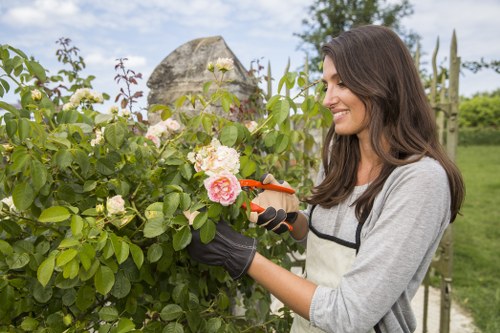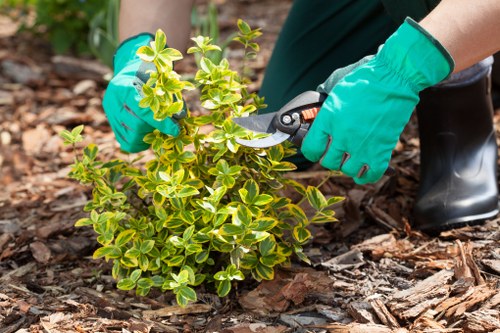Expert Hedge Trimming Services in Hammersmith
Introduction to Hedge Trimming

Hedge trimming is an essential aspect of maintaining the beauty and health of your garden. In Hammersmith, where garden aesthetics are highly valued, proper hedge maintenance ensures that your outdoor space remains inviting and well-kept throughout the year.
Regular trimming not only enhances the appearance of your hedges but also promotes robust growth by removing dead or diseased branches. This practice helps in shaping the hedge, ensuring it fits well within your garden's design.
Moreover, well-trimmed hedges can serve practical purposes, such as providing privacy, acting as windbreaks, and supporting wildlife. Investing in professional hedge trimming services can save you time and ensure that the job is done efficiently and effectively.
Benefits of Professional Hedge Trimming

Opting for professional hedge trimming in Hammersmith offers numerous advantages. Experienced gardeners understand the specific needs of different hedge species, ensuring that each plant receives the appropriate care.
Professionals have the right tools and techniques to perform precise cuts, minimizing the risk of damaging the plants. This expertise leads to healthier hedges with a more aesthetically pleasing shape.
Additionally, hiring experts allows you to focus on other aspects of garden maintenance, confident that your hedges are in good hands. Professional services often include not just trimming but also assessment and advice on hedge health and growth.
Types of Hedges Commonly Trimmed in Hammersmith

In Hammersmith, several hedge varieties are popular among homeowners and gardens. Some common types include:
- Boxwood: Known for its dense foliage and ability to be shaped into intricate forms.
- Privet: Fast-growing and often used for creating privacy screens.
- Laurel: Features glossy leaves and is valued for its robustness.
- Yew: Evergreen and highly tolerant of heavy pruning.
- Beech: Offers a beautiful color contrast and detailed structure.
Each type requires specific trimming techniques to maintain their unique characteristics and health.
When to Trim Your Hedges

Timing is crucial for effective hedge trimming. In Hammersmith, the best times to trim hedges are typically in late spring and late summer. These periods allow the plants to recover quickly and promote healthy new growth.
Trimming in late spring encourages the development of dense new shoots, while late summer trimming helps maintain the desired shape before the colder months. Avoiding extreme weather conditions during trimming ensures the plants are not stressed.
Regular trimming schedules, usually once or twice a year, can prevent overgrowth and reduce the need for more extensive maintenance in the future.
DIY vs. Professional Hedge Trimming

While some garden enthusiasts prefer to handle hedge trimming themselves, there are several reasons to consider professional services in Hammersmith:
- Experience and Skill: Professionals have the expertise to shape hedges perfectly, accommodating their specific growth patterns.
- Time Efficiency: Trimming hedges can be time-consuming. Professionals can complete the job swiftly, allowing you to spend time on other activities.
- Proper Tools: Professionals use specialized equipment that ensures clean cuts and reduces the risk of plant damage.
- Safety: Trimming tall or dense hedges can be hazardous. Experts are trained to handle such tasks safely.
- Long-Term Health: Proper trimming techniques employed by professionals contribute to the long-term health and aesthetics of your hedges.
While DIY trimming can be satisfying, the benefits of professional services often outweigh the costs, especially for large or intricate hedges.
Choosing the Right Hedge Trimming Service in Hammersmith

Selecting a reliable hedge trimming service is essential for achieving the best results. Here are some factors to consider when choosing a provider in Hammersmith:
- Reputation: Look for services with positive reviews and testimonials from satisfied customers.
- Experience: Providers with extensive experience are more likely to handle various hedge types effectively.
- Insurance: Ensure the service is insured to protect against any accidental damage during the trimming process.
- Pricing: Compare quotes from different providers to find competitive rates without compromising on quality.
- Services Offered: Check if the provider offers additional services like hedge health assessment, fertilization, or pest control.
By carefully evaluating these aspects, you can select a hedge trimming service that meets your specific needs and preferences.
Cost of Hedge Trimming in Hammersmith

The cost of hedge trimming in Hammersmith varies based on several factors:
- Size and Height: Larger and taller hedges require more time and resources, increasing the cost.
- Hedge Type: Some hedge varieties are more labor-intensive to trim due to their growth patterns.
- Frequency: Regular maintenance contracts may offer discounted rates compared to one-off services.
- Additional Services: Extra services like pruning, shaping, or health treatments can affect the overall price.
- Accessibility: Hedging areas that are difficult to access may incur higher costs due to the complexity involved.
On average, homeowners in Hammersmith can expect to pay between £100 to £300 for professional hedge trimming services, depending on the aforementioned factors.
Environmental Considerations

Environmental sustainability is becoming increasingly important in gardening practices. Professional hedge trimming services in Hammersmith are adopting eco-friendly methods to minimize their impact:
- Organic Practices: Using organic fertilizers and pest control methods to maintain hedge health without harming the environment.
- Waste Management: Proper disposal or recycling of hedge clippings reduces landfill waste.
- Energy-Efficient Tools: Utilizing equipment that consumes less energy and produces fewer emissions.
- Water Conservation: Implementing water-saving techniques to ensure hedges receive adequate hydration without wastage.
Choosing a service committed to environmental responsibility not only benefits your garden but also contributes to the broader effort of preserving the environment.
Maintaining Hedges Between Trimmings

After professional hedge trimming, maintaining your hedges is essential to prolong the results and ensure continued health. Here are some tips for upkeep:
- Regular Inspections: Check your hedges periodically for signs of disease, pests, or overgrowth.
- Watering: Ensure your hedges receive adequate water, especially during dry periods.
- Fertilizing: Provide nutrients through appropriate fertilizers to promote healthy growth.
- Mulching: Apply mulch around the base to retain moisture and suppress weeds.
- Pruning Dead Branches: Remove any dead or damaged branches as soon as they are noticed.
These routine maintenance practices help keep your hedges in optimal condition between professional trim sessions.
Common Mistakes in Hedge Trimming

Avoiding common mistakes can significantly improve the outcome of your hedge trimming efforts:
- Over-Trimming: Cutting back too much can stress the plants and inhibit healthy growth.
- Improper Timing: Trimming at the wrong time of year can disrupt the hedge's natural growth cycle.
- Using Dull Tools: Dull shears can cause uneven cuts and damage the plant tissue.
- Ignoring Hedge Type: Different hedges require different trimming techniques; neglecting this can lead to poor results.
- Lack of Planning: Not having a clear vision of the desired shape can result in haphazard trimming.
By being aware of these pitfalls, you can ensure that your hedge trimming efforts yield the best possible outcomes.
Seasonal Hedge Trimming Tips
Spring Trimming

Spring is an ideal time for initial hedge trimming. As the weather warms, hedges begin to grow more vigorously. Trimming in spring helps shape the hedges and encourages dense foliage.
Key Tips:
- Start Early: Begin trimming as soon as new growth appears to guide the hedge's shape.
- Remove Dead Branches: Eliminate any dead or diseased wood to maintain plant health.
- Shape Carefully: Aim for a balanced and uniform appearance.
Summer Trimming
Maintaining Growth
Summer trimming focuses on maintaining the hedge's shape as it continues to grow. Regular light trims can prevent overgrowth and keep the hedge tidy.
Key Tips:
- Regular Maintenance: Perform light trims every few weeks to manage growth.
- Water Management: Ensure hedges receive sufficient water during dry spells.
- Monitor for Pests: Keep an eye out for any pest infestations and address them promptly.
Autumn Trimming

Autumn trimming prepares hedges for the winter months. This involves a final shaping and removing any last growth that could be damaged by frost.
Key Tips:
- Final Shaping: Give hedges a final trim to maintain their structure during winter.
- Protect from Frost: Remove any delicate branches that could be harmed by cold weather.
- Clean Up: Ensure all trimmed debris is cleared to prevent disease spread.
Winter Care
Minimal Pruning
During winter, hedge trimming is usually minimal. Focus on removing any damaged branches and preparing the hedge for the upcoming growing season.
Key Tips:
- Inspect for Damage: Check for broken or damaged branches caused by winter weather.
- Light Pruning: Only trim what is necessary to maintain hedge health.
- Plan for Spring: Assess the hedge's condition to plan for the next trimming season.
Proper seasonal care ensures that your hedges remain healthy and attractive throughout the year.
Tools and Equipment for Hedge Trimming

Having the right tools is crucial for effective hedge trimming. Whether you choose to hire a professional or do it yourself, understanding the necessary equipment can enhance the results:
- Shears and Scissors: For precision trimming and shaping.
- Pruning Saws: Essential for cutting through thicker branches.
- Hedge Trimmers: Electric or gas-powered trimmers for larger hedges.
- Ladders: Useful for reaching higher parts of tall hedges.
- Protective Gear: Gloves, safety glasses, and sturdy footwear to ensure safety during trimming.
Investing in quality tools can make the trimming process more efficient and ensure cleaner cuts, promoting healthier hedges.
Hedge Health and Maintenance

Maintaining hedge health goes beyond regular trimming. Proper care ensures that your hedges remain vibrant and resilient against diseases and pests:
Fertilization
- Balanced Nutrients: Use fertilizers that provide essential nutrients to support growth.
- Application Timing: Apply fertilizers in spring and autumn for optimal absorption.
- Organic Options: Consider organic fertilizers to promote sustainable growth.
Pest and Disease Control
Hedges can be susceptible to various pests and diseases. Regular inspections and prompt treatment are vital:
- Identify Early: Look for signs of infestation or disease during each trim.
- Use Appropriate Treatments: Apply insecticides or fungicides as needed, preferably opting for eco-friendly solutions.
- Preventive Measures: Maintain good hygiene and avoid overwatering to reduce disease risks.
Watering Practices
- Consistent Watering: Ensure hedges receive adequate water, especially during dry periods.
- Deep Watering: Water deeply to encourage deep root growth.
- Avoid Overwatering: Prevent waterlogging, which can lead to root rot and other issues.
Comprehensive hedge maintenance promotes longevity and reduces the need for extensive interventions.
Enhancing Garden Aesthetics with Hedges

Hedges play a significant role in garden design, contributing to both functionality and beauty. Thoughtfully trimmed hedges can define spaces, create focal points, and add vertical interest to your garden:
Creating Privacy
- High Hedges: Tall hedges like yews or laurens provide effective privacy screens.
- Dense Planting: Closely planted hedges block visibility while allowing light and air flow.
Defining Spaces
- Garden Rooms: Use hedges to create distinct areas within your garden, such as seating or dining zones.
- Pathways: Line pathways with neatly trimmed hedges to guide visitors and enhance the garden's structure.
Adding Vertical Interest
- Layered Hedges: Combine different hedge heights for a dynamic visual effect.
- Shaped Hedges: Unique shapes add character and intrigue to your garden landscape.
Integrating hedges thoughtfully can elevate your garden's overall appeal, making it a more enjoyable and attractive space.
Seasonal Challenges in Hedge Trimming

Each season brings its own set of challenges for hedge trimming in Hammersmith. Being prepared for these can help in maintaining healthy and beautiful hedges:
Spring Growth Spurts
Rapid growth in spring can lead to overgrown hedges if not managed properly. Regular trims during this period are essential to maintain shape and encourage dense foliage.
Key Strategies:
- Scheduled Trimming: Plan trims at regular intervals to keep growth in check.
- Supportive Pruning: Remove weaker branches to strengthen the overall structure.
Summer Heat and Drought
Hot and dry summers can stress hedges, making proper watering and care critical. Partial trimming can reduce water loss and prevent damage.
Key Strategies:
- Partial Pruning: Trim only a portion of the hedge to allow for adequate air circulation.
- Mulching: Apply mulch to retain moisture in the soil.
Autumn Wind and Debris
Windy autumns can damage hedges and any remaining tender growth. Trimming helps reduce wind resistance and minimizes the risk of breakage.
Key Strategies:
- Strengthening Cuts: Make sure to cut back any weak or overhanging branches.
- Debris Removal: Clear fallen leaves and debris to prevent disease buildup.
Addressing seasonal challenges ensures that your hedges remain robust and well-maintained throughout the year.
Innovative Hedge Trimming Techniques

Advancements in gardening have introduced innovative techniques for hedge trimming, enhancing both efficiency and results:
Topiary
Topiary involves shaping hedges into artistic forms, such as animals or geometric shapes. This technique adds a unique aesthetic element to gardens.
Advantages:
- Creativity: Allows for personalized and creative garden designs.
- Focus Points: Serves as a striking focal point in the landscape.
Feather Trim
The feather trim technique creates a natural, layered look by leaving some branches untrimmed to mimic feathering.
Advantages:
- Natural Appearance: Enhances the natural beauty of the hedges.
- Textural Variety: Adds depth and texture to the garden.
Rejuvenation Pruning
Rejuvenation pruning involves cutting back hedges significantly to stimulate new, healthy growth, particularly for older or overgrown hedges.
Advantages:
- Restores Vitality: Revives neglected or unhealthy hedges.
- Promotes Dense Growth: Encourages bushier and fuller hedges over time.
Incorporating these innovative techniques can elevate the appearance and health of your hedges, making your garden stand out.
Conclusion

Hedge trimming in Hammersmith is a vital practice for maintaining the beauty, health, and functionality of your garden. Whether you choose to undertake the task yourself or hire professional services, understanding the importance of proper trimming techniques, timing, and maintenance is essential.
Professional hedge trimming not only ensures that your hedges look immaculate but also promotes their long-term health and resilience against environmental challenges. By investing in quality services and maintaining regular care, you can enjoy a stunning and well-kept garden all year round.
Contact us today to book your hedge trimming service and transform your garden into a picturesque haven.

